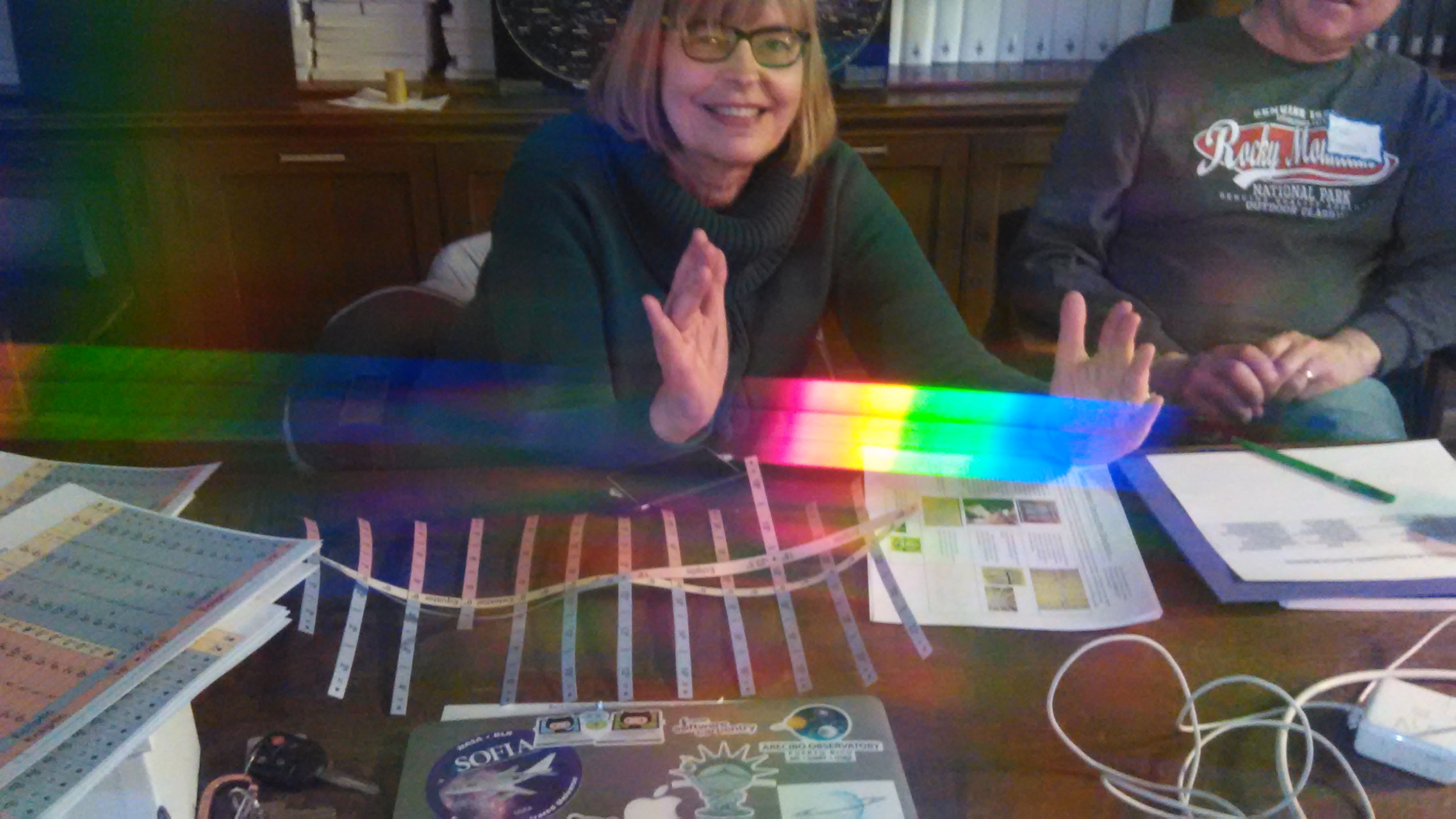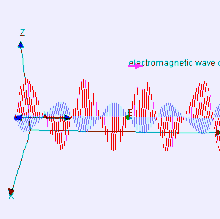Electromagnetic Waves - A Sea of Information
Topic outline
-
 Electromagnetic Waves - a Sea of Information
Electromagnetic Waves - a Sea of Information
Written by: Kathy Gustavson
Grade (Age) level: High School (ages 14-18), UniversityThis course is to help students focus on their efforts in the task of learning about electromagnetic waves.
Topic areas: The characteristics and production of the waves. How astronomers use these waves to study the universe.Vivian "holds" the spectrum at a workshop at Yerkes Observatory
image by KGustavson-
Forum
-
-
One of science's oldest questions is "What is light?" Even though light is all around us, it is not easy to say what it is. The pursuit of this question led to both the theory of relativity and quantum theory. Light and other electromagnetic radiations are important to understanding many of today's societal topics, like communication, satellites, even global warming.
Take the Preview Quiz below to see what you know!
-
Five questions to self-test your basic understanding of EM waves.
-
-
In this section, please view two videos and write about your observations in the journal linked below.
The first video demonstrates the two wave types.
The second video defines specific wave characteristics.
As you watch the videos, write the definitions of the following into Journal 2 below. (You can pause the video while writing!)- Definition of a wave
- Transverse wave
- Longitudinal wave
- Amplitude
- Wavelength
- Velocity
- Period
- Frequency
- Equation for wave speed
-
Journal
-
Have fun changing the settings and see what happens!
(You will need Java to run the simulation)
- Definition of a wave
-
In this section:
- The worksheet will have a brief review of each concept, a possible example problem, and then a problem for you to work.
- Write any notes and solutions to problems in Journal 3.
- Check your answers to the solutions with the solutions worksheet listed below.
- The worksheet will have a brief review of each concept, a possible example problem, and then a problem for you to work.
-
In this section, the question, How does information about the universe come to us?, will be discussed:
- Read the information
- Watch the video
- Take notes and answer the questions in Journal 4 (below)
.

image from wikipedia
Electromagnetic (EM) Waves and their Properties
Electromagnetic radiation propagates through space as a transverse wave. The term “radiation” is NOT referring to radioactivity, but instead to the idea of something that radiates, or spreads away, from its source. The wave nature of light, which is electromagnetic radiation, was discovered in 1801 by Thomas Young in England. In the 1860's, James Clerk Maxwell, a Scottish mathematician and physicist, determined light was electromagnetic radiation.
Let’s explore the nature of light, and thus the nature of electromagnetic radiation, or EM waves:
What do we know about light?
Does it need a material medium to travel through?
What is producing the light wave?
How fast does it travel?
Let’s look at each one of these topics:
1. Does it need a material medium to travel through?
You should be able to answer this question easily: Can we see light from the sun? What does that light travel through?
So yes, light waves, and thus EM waves can travel through a vacuum.

2. 2. What is producing the light wave?
First answer this question: What is the source of all wave motion?
Answer: Something must be oscillating (vibrating)So what is vibrating or oscillating to produce light? What is going up and down like water waves on the ocean? Since light waves travel through the vacuum of empty space, whatever is “waving” cannot be any type of matter.
The answer came from a new understanding of electricity and magnetism. During the 1800’s, a lot of experiments and demonstrations were being done involving these two separate ideas and the concept of a field. During the second half of the 1800's, James Clerk Maxwell combined all the theories developed about electricity, magnetism, and fields, into four equations. The equations showed the phenomena intimately related to each other: a moving electric field generates a magnetic field, and a moving magnetic field generates an electric field. So the “waving” is of these two fields.


Electromagnetic waves can be imagined as a self-propagating transverse oscillating wave of electric and magnetic fields. This 3D animation shows a plane linearly polarized wave propagating from left to right. Note that the electric and magnetic fields in such a wave are in-phase with each other, reaching minima and maxima together. An alternate view of the wave is shown to the right. From Wikipedia, work by:
- Own workBut what is producing the wave in the first place – that is, what starts the electric field, which generates the magnetic field, which generates the electric field, and so forth?
We know if you shake a stick back and forth in water, it produces water waves. Maxwell taught us if you shake an electrically charged object, you produce electromagnetic waves. Therefore, a vibrating electric charge produces electromagnetic radiation.
This could be a charged molecule or atom, or an electron or proton. The moving charge produces an electric field, which produces a magnetic field, which produces an electric field, and so forth. These fields propagates through space. (This is a simplified version of the production, but it will suffice for this module).
3. How fast does it travel?
Maxwell was brilliant in his understanding of how fast the fields travel through space. Using his equations and his understanding of the conservation of energy, he realized the fields generated have to perfectly balance each other. If either field was bigger or smaller, energy would have to be either created or destroyed, thus breaking the law of the conservation of energy. Using his equations, the constant number he found for the propagation of these waves, is the speed of light, c. This confirmed experimentation in 1880 by an American named Albert Michelson, who received a Noble Prize (the first to an American) in 1907 for this work and for the idea that light did not need a medium to travel through (there was no “ether” in space). So:
Speed of light (c) = 3.00 x 108 m/s = 3.00 x 105 km/s
This speed is so fast, it may appear instantaneous to us. If a beam of light could travel around the earth, it would make 7.5 trips in ONE second!
In space, the distances are vast, hence, light takes a measurable time to get to the earth from the stars, the galaxies, and even from our own sun.Example Problem 1:
The sun is an average distance of 150 million km from the earth. (This distance is known as one Astronomical Unit=1 AU.) Let's calculate the time it takes for light to travel from the sun to the Earth:
Use the equation for anything traveling at a constant speed:
speed = distance/time
Rearrange and solve for time:
time = distance/speed
Plug in the appropriate numbers, where 150 million km = 1.5 x 108 km, and speed = c (in kilometers/sec) = 3.00 x 105 km/s:
time = (1.5 x 108 km)/(3.00 x 105 km/s)
time = 500 seconds, which, when divided by 60 seconds, gives: 8.33 minutes.The distance light travels in one year is called a light year (ly). This is a useful unit for measuring some distances in space. There are others, which will be talked about in another project.
Here is a simple video called "light Years Explained" by Joe Collins and the BBC:
Before going to the next section to work problems and discuss the range of frequencies and wavelengths this equation generates, answer the following five questions in Journal 4 (below):
1. T 1. The constant speed of an electromagnetic wave in space is a consequence of which central principle in physics?
2. What does a changing magnetic field induce?
3. What does a changing electric field induce?
4. What produces electromagnetic waves?
5. What do electric and magnetic fields contain and transport?Se See the solution sheet to the five questions.
- Read the information
-
In this section,
- Read about the electromagnetic spectrum
- Watch the video from NASA
- Take notes and work the problems in Journal 5 (below)
Intro:
Once light was determined to have a wave nature, experimenters looked to find and confirm the wavelength of visible light. The wavelengths at which the human retina is sensitive to are extremely small and not easily detectable. The unit used for these wavelengths is the nanometer (nm), where 1 nm = 10-9 meters. Experiments determined that visible light has wavelengths covering the range from about 400 nm for violet light to 700 nm for red light. (Some scientists prefer to measure wavelengths in Angstroms, where one Angstrom is 10-10 meters. This project will use nanometers.)
image credit: http://solar-center.stanford.edu/
Maxwell realized his equations did not place any limits on the wavelength, and hence frequency, of electromagnetic radiation: Electromagnetic waves could exist with wavelengths both longer and shorter than the range of visible light.
Consequently, researchers started to look for invisible light. The range of all wavelengths, including both visible and invisible light, is now called the electromagnetic spectrum.

Image credit:NASA
The most important characteristic of all these waves is their speed - it is the same as the speed of light!
Mathematically, using c for the speed of electromagnetic waves in the equation for the speed of a wave, v=λf, we can write:c=λf
(speed of light = wavelength x frequencyDownload the worksheet at the end of this section (after the videos) for the questions and problems related to this section. Answer these in Journal 5.
- Read about the electromagnetic spectrum
-
For thousands of years humans have looked at the sky and the visible light raining down from space. Little did they know that light is only a small part of the sea of information available for understanding the universe. This section introduces some of the instruments astronomers use to look at other EM radiation, and why these other wavelengths are important in the study of astronomy.
In this section:
- Read the first article from NASA Science News 1999 (the last part is a little outdated)
- Do the interactive activity "Astronomical Images in Different Wavelengths" from PBS Learning Media.
 Look at this image: What types of EM waves make it through our atmosphere?
Look at this image: What types of EM waves make it through our atmosphere?-
This is a NASA article on why we need different kinds of telescopes to look at outer space - from 1999, but still an excellent article!
Answer these questions in Journal 6, part a.)- How do telescopes rely on the interaction between energy and matter?
- Can one telescope detect all EM waves? Why or why not?
- Who discovered the first EM waves coming from space that were not visible light?
- List several other types of telescopes for the different EM waves and give some information about each.
- How do telescopes rely on the interaction between energy and matter?
-
This is an interactive look at images in different wavelengths and the telescopes that observe them.
In Journal 6, part b.)
- Write about each of the 4 objects and their image sets.
- What is you favorite image in each set? Why?
- Click on the Telescope link: List the telescopes in Journal 6. Pick one of the telescopes and discuss it in more detail.
- Write about each of the 4 objects and their image sets.
-
Two Projects:
A. Pick a part of the spectrum other than visible light:
- Discus the range of frequencies and wavelengths of this part of the spectrum. Use the equation to show the ranges (show work).
- Discuss the energy content of this part of the spectrum
- What is the source of this radiation?.
- Discuss the type of equipment needed to detect this part of the spectrum.
- What is this part of the spectrum used for? Are there applications?
Note: This report should be done in Journal 7. Include images.
B. Humans evolved such that the eye is most sensitive to the same wavelength range as the Sun's greatest intensities.
- Discuss, in Journal 7, the idea of evolving on a planet around a star that emits a different range of EM radiation. Be creative as to what these creatures might be like.
- Discus the range of frequencies and wavelengths of this part of the spectrum. Use the equation to show the ranges (show work).
-
Please let us know your thoughts about this course by using the discussion forum below
- What was your favorite activity?
- What was the most important part of the course for you?
- Are there any areas that need improvement?
- How was the length of the course?
- Any additional comments
After you use the discussion forum, please answer the BRIEF survey questions in the link below.
Thank You!!!
-
Forum
-
Brief!
